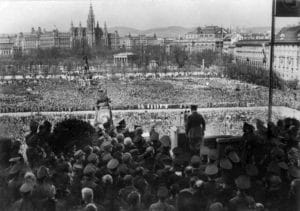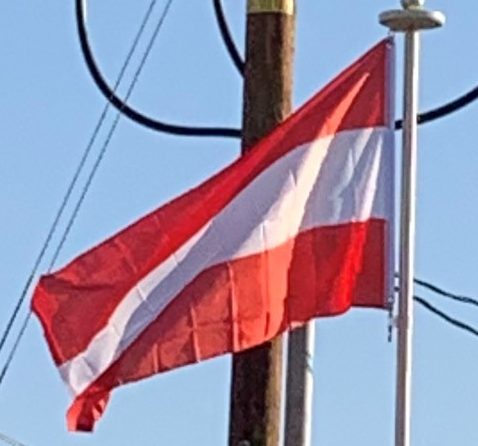The First Austrian Republic lasted until 1933, when Chancellor Engelbert Dollfuss, using what he called “self-switch-off of Parliament“, established an autocratic regime tending towards Italian fascism. The two big parties at this time, the Social Democrats and the Conservatives, had paramilitary armies; the Social Democrats’ Schutzbund was now declared illegal, but was still operative as civil war broke out.
In February 1934, several members of the Schutzbund were executed, the Social Democratic party was outlawed, and many of its members were imprisoned or emigrated. On 1 May 1934, the Austrofascists imposed a new constitution (“Maiverfassung”) which cemented Dollfuss’s power, but on 25 July he was assassinated in a Nazi coup attempt.
His successor Kurt Schuschnigg acknowledged Austria as a “German state” and that Austrians were “better Germans” but wished for Austria to remain independent. He announced a referendum on 9 March 1938, to be held on 13 March, concerning Austria’s independence from Germany. On 12 March 1938, Austrian Nazis took over government, while German troops occupied the country, which prevented Schuschnigg’s referendum from taking place. On 13 March 1938, the Anschluss of Austria was officially declared. Two days later, Austrian-born Hitler announced what he called the “reunification” of his home country with the “rest of the German Reich” on Vienna’s Heldenplatz. He established a plebiscite confirming the union with Germany in April 1938.
Parliamentary elections were held in Germany (including recently annexed Austria) on 10 April 1938. They were the final elections to the Reichstag during Nazi rule, and took the form of a single-question referendum asking whether voters approved of a single Nazi-party list for the 813-member Reichstag, as well as the recent annexation of Austria (the Anschluss). Jews and Gypsies were not allowed to vote. Turnout in the election was officially 99.5%, with 98.9% voting “yes”. In the case of Austria, Adolf Hitler’s native soil, 99.71% of an electorate of 4,484,475 officially went to the ballots, with a positive tally of 99.73%. Although most Austrians favored the Anschluss, in certain parts of Austria the German soldiers were not always welcomed with flowers and joy, especially in Vienna which had Austria’s largest Jewish population. Nevertheless, despite the propaganda and the manipulation and rigging which surrounded the ballot box result, there was massive genuine support for Hitler for fulfilling the Anschluss, since many Germans from both Austria and Germany saw it as completing the long overdue German unification of all Germans united into one-state.

On 12 March 1938, Austria was annexed to the Third Reich and ceased to exist as an independent country. The Aryanisation of the wealth of Jewish Austrians started immediately in mid-March, with a so-called “wild” (i.e. extra-legal) phase, but was soon structured legally and bureaucratically to strip Jewish citizens of any assets they possessed. The Nazis renamed Austria in 1938 as “Ostmark” until 1942, when it was again renamed and called “Alpine and Danubian Gaue” (Alpen-und Donau-Reichsgaue).
Though Austrians made up only 8% of the population of the Third Reich, some of the most prominent Nazis were native Austrians, including Adolf Hitler, Ernst Kaltenbrunner, Arthur Seyss-Inquart, Franz Stangl, and Odilo Globocnik, as were over 13% of the SS and 40% of the staff at the Nazi extermination camps. Vienna fell on 13 April 1945, during the Soviet Vienna Offensive, just before the total collapse of the Third Reich. The invading Allied powers, in particular the Americans, planned for the supposed “Alpine Fortress Operation” of a national redoubt, that was largely to have taken place on Austrian soil in the mountains of the eastern Alps. However, it never materialized because of the rapid collapse of the Reich.
